
Handmade, Ever Relevant: Ithra Show Honors Timeless Craftsmanship
“In Praise of the Artisan,” an exhibition at Ithra in Dhahran, Saudi Arabia, aims to showcase Islamic arts-and-crafts heritage and inspire the next generation to keep traditions alive.
A long mashrabiya "window" made of thousands of pieces of turned wood that are fitted together with no nails or glue stands opposite a jali screen delicately carved from white marble. The mashrabiya masterpiece fronts a room holding traditional wood and textile furnishings from Egypt and elsewhere in the Arab and Muslim worlds.
Crafted in geometric patterns and used to solve problems of heat, light and privacy, mashrabiyas form an aesthetic ornamental symbol of Islamic architecture.
The piece is part of "In Praise of the Artisan," an exhibition celebrating traditional Islamic craftwork that is "bringing the past to the future" at the King Abdulaziz Center for World Culture (Ithra) in Dhahran, Saudi Arabia. The goal is to showcase Islamic arts-and-crafts heritage and keep traditions alive.

Left: Adham Nadim's sister, Hend, fits together pieces of paneling; Adham Nadim and his wife, Hind Mostafa, display woodwork in the Nadim workshop near Cairo, Egypt; Right: Adham Nadim watches a master craftsman carve a panel similar to those in the Ithra show.
Arthur Clark
Adham Nadim, like other artisans participating in the exhibition, is striving to bridge tradition to modern times. That way, Nadim says, a society can understand—and learn from—its past.
Nadim and a team of woodworkers built the mashrabiya room at their sprawling workshop about 30 kilometers (18.5 miles) west of Cairo. Mashrabiya represents a vital aspect of Egyptian craftwork dating back centuries that was facing extinction 50 years ago.
That's when Nadim's father and mother—newly minted Ph.D.s with backgrounds in folklore and anthropology, respectively—stepped in, establishing a workshop for four craftsmen in their garage in Cairo. They wanted to "bring things back to their authentic time, to do the work properly [in accord with] their original status of appreciation and perfection," he noted.
Much the same can be said of the exhibition as a whole. It "provides a golden opportunity for artisans to speak," said Idries Trevathan, expert in Islamic art and culture at Ithra, who curated the exhibition.
Islamic artistic tradition is not something "from a dead and distant past," he said. "We want to show that it's still practiced in different places around the world. We highlight those places where these certain crafts are practiced at a very high level."
For Nadim, the show offered the opportunity to express "a sense of national collective pride and identity, not only for us as Egyptians but extending regionally. We feel that it is important to preserve our identity and maintain our [cultural] DNA … to show the world that our inherited know-how can withstand the test of time and adapt to modern needs."
We feel that it is important … to show the world that our inherited know-how can withstand the test of time and adapt to modern needs.
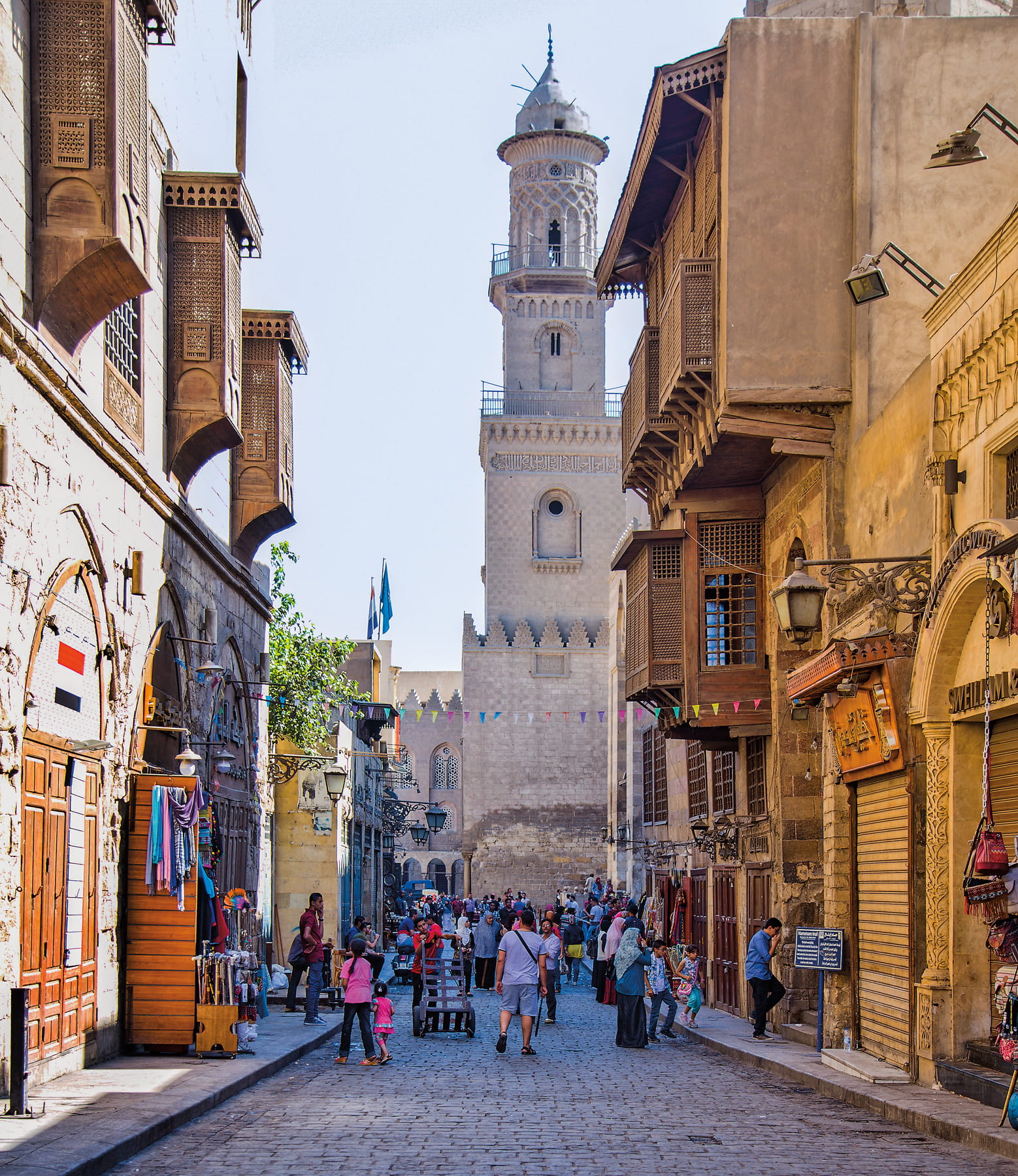
Windows clad in different types on mashrabiyas line a street in the Khan El Khalili area of Cairo. Rather than place them as standalone objects behind glass, Ithra shows the screens as they would appear in settings such as this.
Waleed Dashash
"Traditional arts and crafts are a vehicle for sustainable development through true and decent job creation," he said.
"[These] forms and expressions that have been created over several hundreds if not thousands of years need to be protected and given the chance to survive to future generations," said Nadim.
History of Islamic Craftsmanship
Indeed, "In Praise of the Artisan" evokes a deep appreciation for creative expression in a variety of forms going back thousands of years.
That rich craft amalgam took a huge hit with the rise of industrialization and global marketing for mass-produced objects beginning in the mid-1800s, according to Trevathan. Under the influence of Western thinking, the perception of craftwork as different from—and of less merit or value than—art took hold around the same time.
"In the early or premodern Islamic period, there was no distinction between art and craft. That's purely a European or Western idea that resolved into the Muslim world," said Trevathan.

“In Praise of the Artisan” highlights tilework from the last Muslim kingdom in Spain, including part of a wall, left. Behind it is the Levantine Room from Damascus, Syria, featuring the ‘Ajami technique of raised gesso wood paneling and a striking marble floor.
Waleed Dashash
A "trend" in Islamic art history textbooks to exclude traditional work began "around the 1750s or early 1800s," he noted. "It's almost as if Muslim craftsmen just stopped producing. They often present it kind of like Europeans took over, replacing tradition."
The exhibition aims "to show that contemporary art can also be traditional … that there is no gap between an artist and an artisan. We feel that traditional Islamic art is timeless and always relevant."
Ithra reached out to master craftspeople as far apart as southern Spain and Malaysia to commission works in calligraphy, textiles, ceramics, wood and stone for the show. It also features some 140 more striking objects in those categories, as well as metal and glass, from its collection and the al-Sabah and the Tareq Rajab Museum collections in Kuwait.
Nadim's mashrabiya room is styled after Bayt al-Suhaymi, a 17th-century house in Old Cairo that expanded over generations of family occupation. He and his team restored the rundown building to its former glory in a six-year project completed in 2000, spurring the revitalization of more than 30 traditional buildings and houses in the area.
Nadim lauds the show because it enables visitors to view key works in natural settings, rather than as standalone objects behind glass.
Mashrabiya screens were widely used starting some 900 years ago in the Islamic West to provide privacy, often separating interior courtyards from surrounding corridors, as well as from the street, notes the exhibition catalog. The screen in the exhibition "was inspired by the patterns seen along typical historic[al] streets of Cairo," said Nadim.
In addition to commissioned works, the exhibit features 140 pieces from Ithra’s collection and Kuwait’s al-Sabah and Tareq Rajab Museum collections.
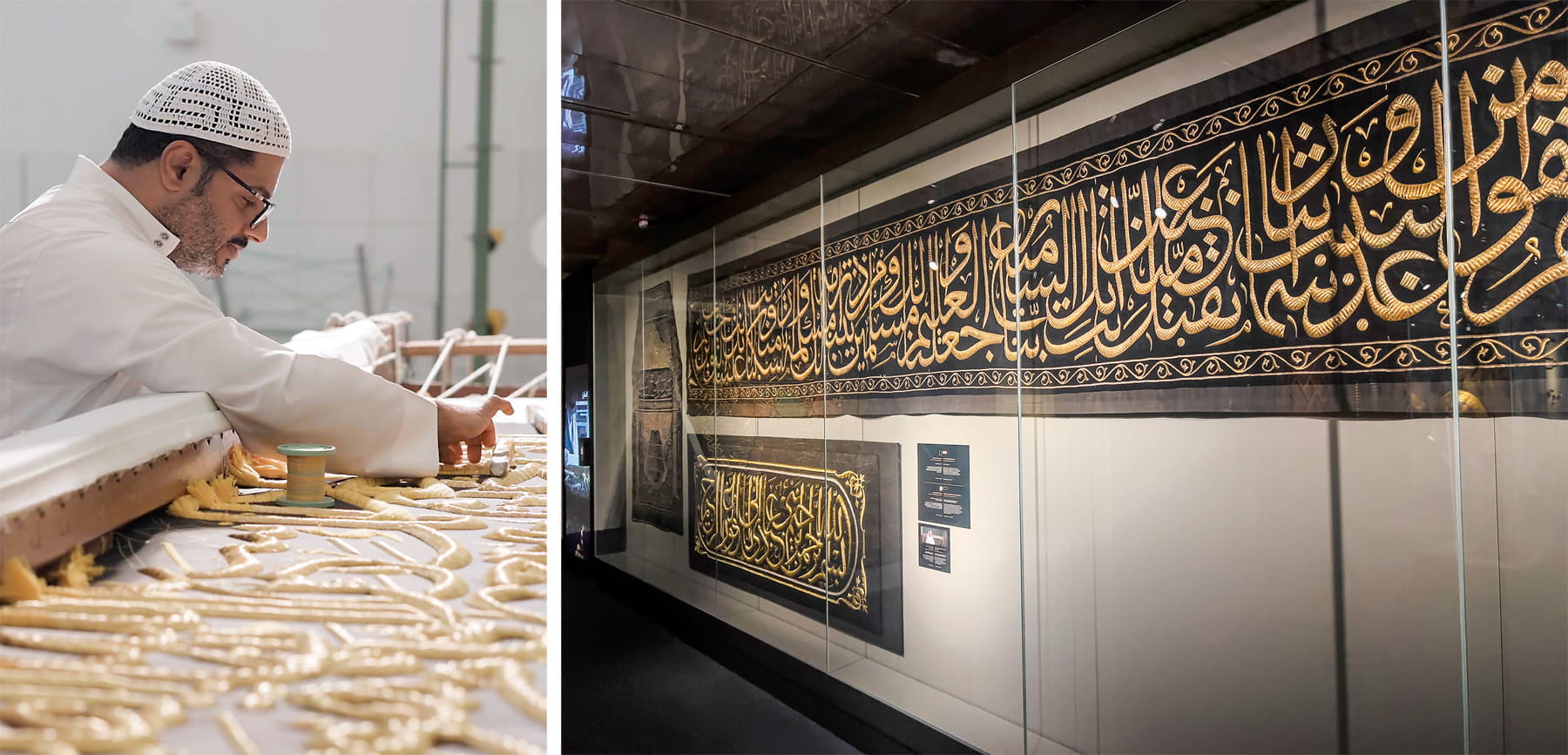
Left: Audiovisual vignettes include an artisan working on the raised embroidery on the kiswah that covers the Ka’aba, the door to the Great Mosque in Makkah. Right: A case displays a panel from the kiswah.
Right: Waleed Dashash
In fact, it could have come straight out of Palace Walk by Nobel Prize winner Naguib Mahfouz. Set in Old Cairo in the early 1900s, the novel describes a household both protected by and isolated from the street below by a mashrabiya screen. Along with providing breezes and light for the house, the mashrabiya offered psychological aid to a new young bride.
"When she was left alone," Mahfouz wrote, "[she would] rush to the latticework screen at the window to peer anxiously through it at the lights of the carts and the coffeehouses, listening carefully for a laugh or cough to help her regain her composure."
Nadim came naturally to his profession. He earned a degree in Islamic art and architecture from the American University in Cairo and became CEO of Nadim Industries in 1999.
His company now employs 800 master craftsmen and apprentices as well as designers using high-tech computer tools, who can shift overnight from making Western-style furniture to crafting traditional pieces.
Each of the commissioned works in the exhibition was a major project. The mashrabiya room took about a year from planning to completion, said Nadim. It was transported by truck and by sea in eight large crates and installed at Ithra in about a week by about a dozen craftsmen from the workshop.
We highlight those places where these certain crafts are practiced at a very high level.

Above and right: For the Ithra exhibition, Ustad Siddique Bhati’s team carved a ceiling-high jali screen similar to this one in Rajasthan, India.
The Exhibition
The three-year exhibition, which opened in November 2024, offers works by master artisans from renowned craft centers in the historical Muslim world.
A commissioned rendering in calligraphy of the bismillah ("in the name of God") by Deniz Öktem Bektaş, from Istanbul, Türkiye, opens the exhibition. That's fitting, for Muslims traditionally begin tasks with that invocation. Another commission, a mihrab (prayer niche) clad in vividly colored tilework by Abdul Rahman Toirov from Samarkand, Uzbekistan, stands at the opposite end of the room, overlooking three huge carpets from Syria and Iran dating to the 16th and 17th centuries.
Just steps away from the room featuring the mashrabiya is the Levantine Room from Damascus, Syria. The striking chamber, which falls outside the realm of works commissioned for the show, was part of a house built near the Umayyad Mosque in the late 18th century. When the house was torn down in the early 1970s, the room was sold and shipped to a resident of Beirut. Featuring rich 'Ajami decoration (painted gesso reliefs and woodwork) on its walls and ceiling and a spectacular marble floor, it arrived at Ithra just in time to be included in the exhibition.
Each commissioned piece is accompanied by an audiovisual vignette portraying the artisan or artisans who made it. A separate vignette focuses on the clothing of the Ka'aba in Makkah, Saudi Arabia.
The latter shows off embroidery from the kiswah covering of the Ka'aba, including a large silk sitarah, or curtain, for the Ka'aba door that was made in Egypt and likely hung over it in 1909. Its rich colors contrast with a more subdued panel for a sitarah made in Makkah in 2024 as a gift and never hung.
The last kiswah from Cairo came in 1962, after which kiswah manufacturing moved completely to Makkah.

A digital screen depicts weaver Zainun binti Jusoh of Malaysia next to her songket textile, which involved special tying and dyeing of threads.
Waleed Dashash
Nearly bisecting the room longitudinally is a 16-meter-long, ceiling-high jali screen carved from the same white marble as the Taj Mahal by a team led by Ustad Siddique Bhati in Rajasthan, India.
Another commissioned work is a gleaming lusterware jar 132 centimeters (4.3 feet) tall and 68.7 meters (2.25 feet) wide by Shuaib Sanchez from Granada, Spain. Seated in an alcove decorated with Moroccan zillij tiles and delicately carved plaster, it is modeled on one of the jars dating to the Nasrid Dynasty, the last Muslim kingdom in Spain, which ruled from the Alhambra in Granada from 1232 to 1492.
"We threw out the rulebook" for the show, said Trevathan. "We worked with the craftspeople to create architectural settings to use as the lens … to exhibit all the work here," he noted, pointing to the jali screen and the mashrabiya, which seem engaged in conversation over a display of metal, glass and ceramic work from across the Muslim world.
On the opposite wall, a radiant songket commissioned from Zainun binti Jusoh in Terengganu, Malaysia, dazzles the eye. Woven in brilliant green silk, it is intricately patterned with gold metallic threads.
Songket, a type of weaving featuring brocaded designs on wool or cotton—sometimes with interwoven gold or silver metallic threads—flourished in Malaysia beginning in the 15th century. It is traditionally used for clothing like sarongs. Real gold and silver threads are used in songket fabric for royalty.
It took Zainun binti Jusoh more than a year to weave her brilliant songket for the exhibition. The work required one more step than the eight required to make a simple songket. It involved a special kind of tying and dying threads to make limar songket, called the "Queen of Songket" in Malaysia.
Master craftspeople as far apart as Spain and Malaysia contributed works in calligraphy, textiles, ceramics, wood and stone.
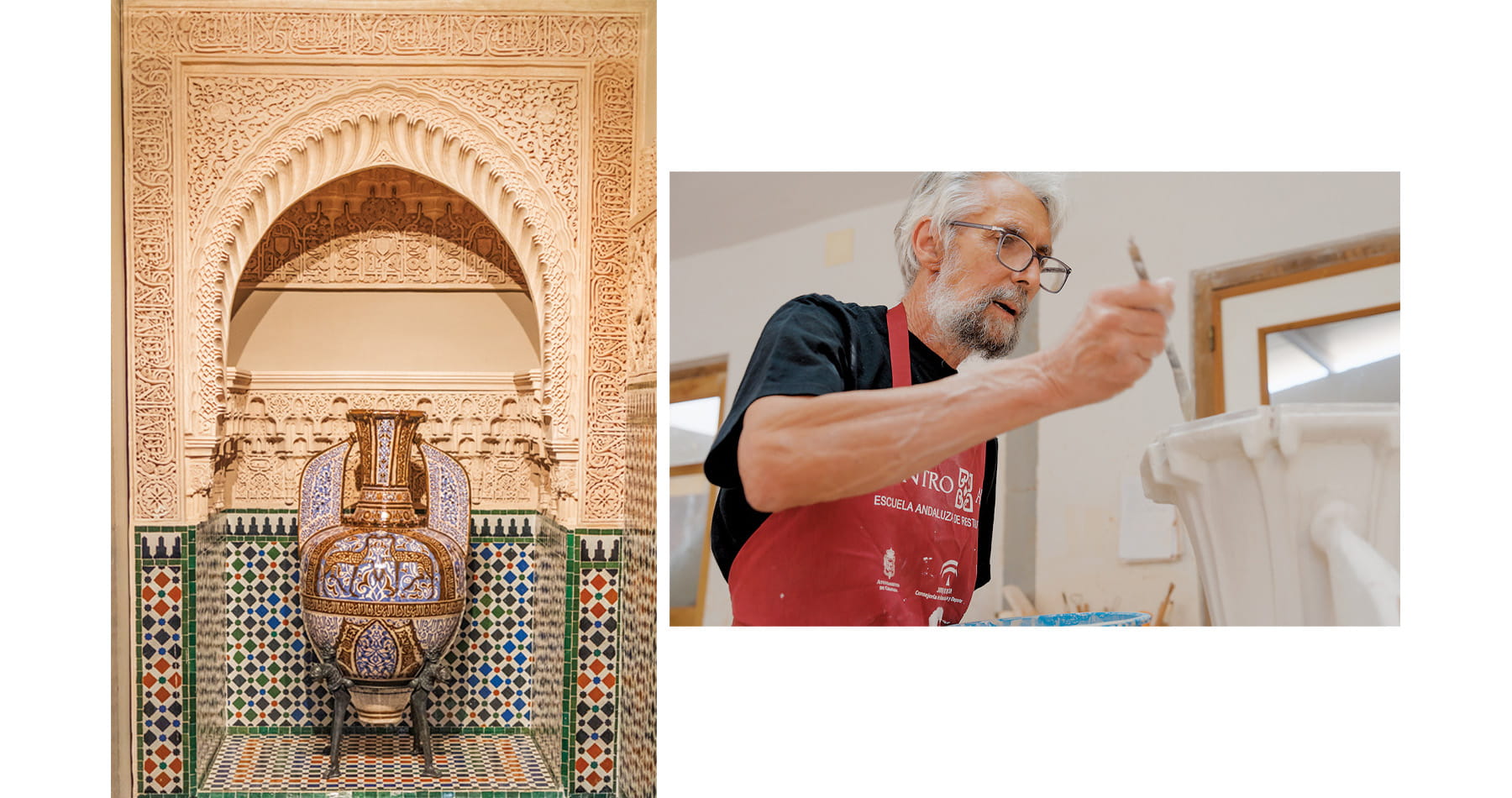
Left: Displayed in an alcove bearing Moroccan zillij tiles and carved plaster at the exhibition, a lusterware vase from Granada, Spain, is modeled after a jar dating to the Nasrid Dynasty. Right: Shuaib Sanchez works on the vase.
Left: Waleed Dashash; Right: ITHRA
As with Nadim's story, her family strongly influenced her lifework. She and her mother, from whom she learned to make limar songket, are among the few weavers who know that otherwise lost art. She is the fifth generation of her family to practice songket weaving.
But it may also be the last. Her family business employed 300 weavers in the 1990s. Today the number has shrunk to about 60. Although her son, Luqman, hopes to open a new songket workshop to train apprentices, "my generation may be the last generation," she says. "That makes me sad."
The survival of traditional craftwork in the face of new fashions and changing economic conditions remains in question. There is a path to success in the marketplace, as represented by the woodwork of Nadim. The work of Zainun binti Jusoh, facing strong economic headwinds due to the popularity of cheaper, mass-produced songket fabric, represents the other side of the craftwork coin.
Whatever the result, "In Praise of the Artisan" takes a beautiful step in bridging the divide between the work of craftspeople and that of artists—seeing them as part of a single expression of the same human spirit.
Exhibition organizers say traditions are one of the greatest aspects of Islamic art.
Abdullah Munif, a Riyadh resident who visited the exhibition in June, agreed. "It's very good to continue traditions," he said.
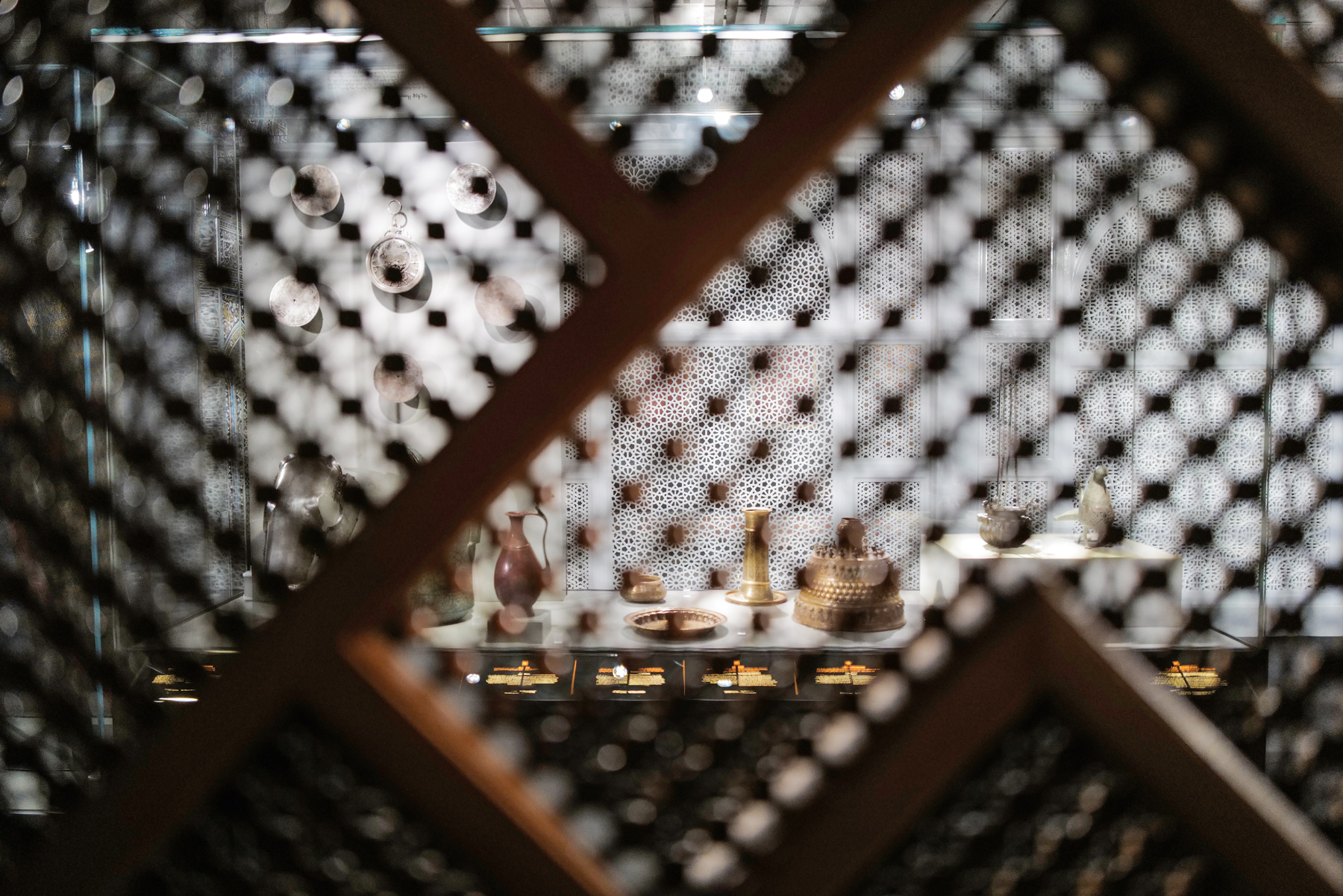
Visitors looking from inside the mashrabiya to other parts of the exhibit can appreciate its beauty and privacy function.
Arthur Clark
His wife, Reem, said she sees the value as well. "Here, we are able to get close to our heritage," she said. "We have a great civilization that the current generation must learn about and emulate. This is bringing the past to the future."
Or, as Nadim put it: "We believe that one of the goals of the Ithra exhibition is to open the eyes of visitors, so that we have something here that can be taken from it, something that one can be proud of that belongs to all of us, to take inspiration from it … to create an identity that distinguishes from the other."
More From AramcoWorld
The Box Balconies of Lima
You may also be interested in...

History in Objects: 12th-Century Glass Flask an Islamic Golden Age Masterpiece
History
Arts
Golden Vessel From the Islamic Golden Age Reflects Cross-cultural Connections
Nasreen ki Haveli: Pakistani Textile Museum Fulfills a Dream
Arts
Collector Nasreen Askari and her husband, Hasan, have turned their home into Pakistan’s first textile museum.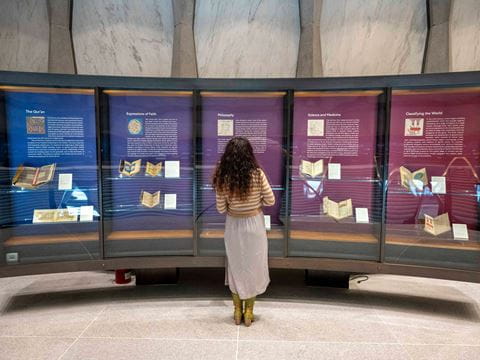
Mundane to Magnificent: Yale Manuscript Exhibition Illuminates Muslim Knowledge
Arts
Manuscript exhibition reveals handwritten treasures spanning centuries and nations, in graying script and glorious technicolor, on ancient papyrus and gold-coated paper.
